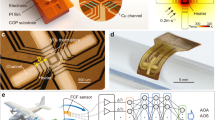Abstract
Many collective behaviors in social insects are mediated by airflow, such as honeybees fanning their wings to drive nest ventilation or to disperse pheromones during olfactory search and aggregation. Empirical investigations of how the local sensing and actuation of individual insects scale up to produce such large scale flows require distributed flow measurement techniques. Common vision-based techniques, however, are not workable in the cluttered dynamic environments in which these social insects live and behave. Here, we developed a customizable, low-cost 2D flow sensor that can measure both magnitude and direction and be deployed in dense sensor arrays on experimental surfaces. While many 2D thermal flow sensor designs have been published, our minimal design uses off-the-shelf components and standard fabrication techniques that should be accessible to most research groups. Here we report on the design and performance of our sensor and provide a user-friendly calibration protocol. The sensor has a measurement range of 0–2 m/s with accuracy of 0.1 m/s, angular resolution of \(15^\circ\), and a time constant of 3 s. We also discuss modifications that can be made to tune sensor performance for a given application.










Similar content being viewed by others
References
Perna A, Theraulaz G (2017) When social behaviour is moulded in clay: on growth and form of social insect nests. J Exp Biol 220(1):83. https://doi.org/10.1242/jeb.143347
Petersen K, Nagpal R (2017) Complex design by simple robots: a collective embodied intelligence approach to construction. Arch Des 87(4):44
Peters JM, Gravish N, Combes SA (2017) Wings as impellers: honey bees co-opt flight system to induce nest ventilation and disperse pheromones. J Exp Biol 220(12):2203. https://doi.org/10.1242/jeb.149476
Peters JM, Peleg O, Mahadevan L (2019) Collective ventilation in honeybee nests. J R Soc Interface 16(150):20180561. https://doi.org/10.1098/rsif.2018.0561
Peters JM, Petersen KH (2020) Honeybee swarms use a flow-mediated pheromone signaling scheme to coordinate aggregation. SICB 60:E185–E185
King H, Ocko S, Mahadevan L (2015) Termite mounds harness diurnal temperature oscillations for ventilation. Proc Natl Acad Sci 112(37):11589. https://doi.org/10.1073/pnas.1423242112
Zhu Y, Chen B, Qin M, Huang Q (2014) 2-D micromachined thermal wind sensors—a review. IEEE Internet Things J 1(3):216. https://doi.org/10.1109/JIOT.2014.2319296
Que R, Zhu R (2015) A compact flexible thermal flow sensor for detecting two-dimensional flow vector. IEEE Sens J 15(3):1931. https://doi.org/10.1109/JSEN.2014.2367017
Zhu R, Que R, Liu P (2017) Flexible micro flow sensor for micro aerial vehicles. Front Mech Eng 12(4):539. https://doi.org/10.1007/s11465-017-0427-0
Wang S, Yi Z, Qin M, Huang Q (2018) A 2D wind sensor using the \(\Delta\)P thermal feedback control. J Microelectromech Syst 27(3):377. https://doi.org/10.1109/JMEMS.2018.2812805
Ye Y, Yi Z, Gao S, Qin M, Huang Q (2018) Octagon-shaped 2-D micromachined thermal wind sensor for high-accurate applications. J Microelectromech Syst 27(4):739. https://doi.org/10.1109/JMEMS.2018.2849086
Barmpakos D, Famelis IT, Moschos A, Marinatos D, Kaltsas G (2019) Design and evaluation of a multidirectional thermal flow sensor on flexible substrate. J Sens. https://doi.org/10.1155/2019/8476489
Gao S, Yi Z, Ye Y, Qin M, Huang Q (2019) Temperature effect and its compensation of a micromachined 2-D anemometer. IEEE Sens J 19(14):5454. https://doi.org/10.1109/JSEN.2019.2906192
Lan Y, Zou Y, Ma X, Shi Y, Fan J, Hai Y, Wang X, Yang J, Feng Q (2020) Fabrication and characterization of dual coordinate self examined thermal flow sensor arrays based on longitudinal heat conduction. IEEE Sens J 20(1):434. https://doi.org/10.1109/JSEN.2019.2941531
Shen G, Qin M, Huang Q (2010) A cross-type thermal wind sensor with self-testing function. IEEE Sens J 10(2):340. https://doi.org/10.1109/JSEN.2009.2034625
Liu H, Lin N, Pan S, Miao J, Norford LK (2013) High sensitivity, miniature, full 2-D anemometer based on MEMS hot-film sensors. IEEE Sens J 13(5):1914. https://doi.org/10.1109/JSEN.2012.2236014
Nguyen DMT, Iuzzolino ML, Mankel A, Bozek K, Stephens GJ, Peleg O (2021) Flow-mediated olfactory communication in honeybee swarms. Proc Natl Acad Sci 118(13): e2011916118. https://doi.org/10.1073/pnas.2011916118
Acknowledgements
This work was supported by a National Science Foundation (NSF) Award (#1739671), a Cornell Louis Stokes Alliance for Minority Participation (LSAMP) Award, and the Packard Fellowship for Science and Engineering.
Author information
Authors and Affiliations
Corresponding author
Additional information
Publisher's Note
Springer Nature remains neutral with regard to jurisdictional claims in published maps and institutional affiliations.
This work was presented in part at the joint symposium with the 15th International Symposium on Distributed Autonomous Robotic Systems 2021 and the 4th International Symposium on Swarm Behavior and Bio-Inspired Robotics 2021 (Online, June 1–4, 2021).
About this article
Cite this article
Defay, J.A., Peters, J.M. & Petersen, K.H. A customizable, low-cost alternative for distributed 2D flow sensing in swarms. Artif Life Robotics 27, 272–277 (2022). https://doi.org/10.1007/s10015-022-00760-z
Received:
Accepted:
Published:
Issue Date:
DOI: https://doi.org/10.1007/s10015-022-00760-z




